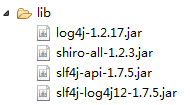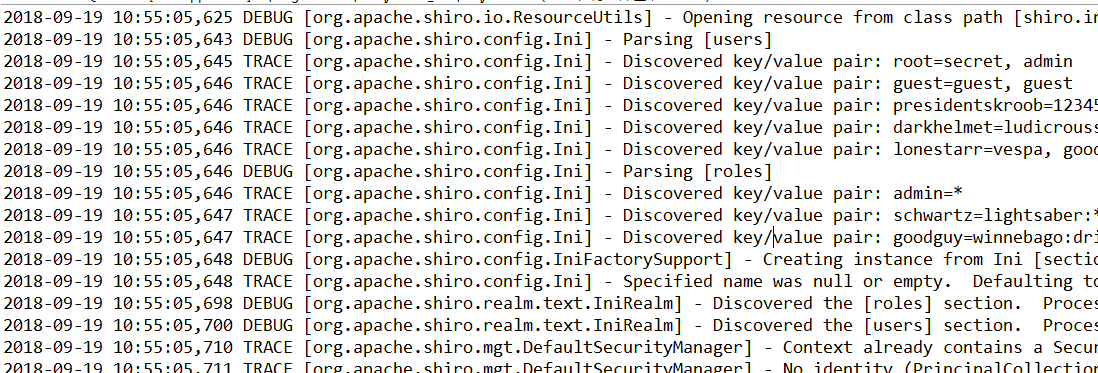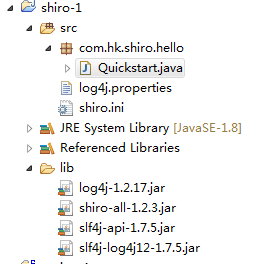【HelloWorld Shiro】
1.搭建开发环境-加入jar包

2.步骤(前提:已下载好Shiro资源包):
①找到shiro-root-1.2.3-source-release包,

②按Apache Shiroshiro-root-1.2.3-source-releaseshiro-root-1.2.3samplesquickstartsrcmain esources路径找到,将log4j.properties,shiro.ini文件加入到类路径(src)下,
③创建一个包,将Apache Shiroshiro-root-1.2.3-source-releaseshiro-root-1.2.3samplesquickstartsrcmainjava下的Quickstart.java文件放入包中。(注意:在该java代码中要添加包名代码)

3.运行结果:一大堆东西

附:

Quickstart.java:
1 package com.hk.shiro.hello; 2 3 /* 4 * Licensed to the Apache Software Foundation (ASF) under one 5 * or more contributor license agreements. See the NOTICE file 6 * distributed with this work for additional information 7 * regarding copyright ownership. The ASF licenses this file 8 * to you under the Apache License, Version 2.0 (the 9 * "License"); you may not use this file except in compliance 10 * with the License. You may obtain a copy of the License at 11 * 12 * http://www.apache.org/licenses/LICENSE-2.0 13 * 14 * Unless required by applicable law or agreed to in writing, 15 * software distributed under the License is distributed on an 16 * "AS IS" BASIS, WITHOUT WARRANTIES OR CONDITIONS OF ANY 17 * KIND, either express or implied. See the License for the 18 * specific language governing permissions and limitations 19 * under the License. 20 */ 21 22 import org.apache.shiro.SecurityUtils; 23 import org.apache.shiro.authc.*; 24 import org.apache.shiro.config.IniSecurityManagerFactory; 25 import org.apache.shiro.mgt.SecurityManager; 26 import org.apache.shiro.session.Session; 27 import org.apache.shiro.subject.Subject; 28 import org.apache.shiro.util.Factory; 29 import org.slf4j.Logger; 30 import org.slf4j.LoggerFactory; 31 32 33 /** 34 * Simple Quickstart application showing how to use Shiro's API. 35 * 这是一个简单地快速开始,来演示怎么用Shiro 的API。 36 * @since 0.9 RC2 37 */ 38 public class Quickstart { 39 40 private static final transient Logger log = LoggerFactory.getLogger(Quickstart.class); 41 42 public static void main(String[] args) { 43 44 // The easiest way to create a Shiro SecurityManager with configured 45 // realms, users, roles and permissions is to use the simple INI config. 46 // We'll do that by using a factory that can ingest a .ini file and 47 // return a SecurityManager instance: 48 49 // Use the shiro.ini file at the root of the classpath 50 // (file: and url: prefixes load from files and urls respectively): 51 Factory<SecurityManager> factory = new IniSecurityManagerFactory("classpath:shiro.ini"); 52 SecurityManager securityManager = factory.getInstance(); 53 54 // for this simple example quickstart, make the SecurityManager 55 // accessible as a JVM singleton. Most applications wouldn't do this 56 // and instead rely on their container configuration or web.xml for 57 // webapps. That is outside the scope of this simple quickstart, so 58 // we'll just do the bare minimum so you can continue to get a feel 59 // for things. 60 SecurityUtils.setSecurityManager(securityManager); 61 62 // Now that a simple Shiro environment is set up, let's see what you can do: 63 64 // get the currently executing user: 65 //获取当前的subject,调用SecurityUtils.getSubject() 66 Subject currentUser = SecurityUtils.getSubject(); 67 68 // Do some stuff with a Session (no need for a web or EJB container!!!) 69 //测试使用session 70 //获取Session,调用subject的getSession()方法 71 Session session = currentUser.getSession(); 72 session.setAttribute("someKey", "aValue"); 73 String value = (String) session.getAttribute("someKey"); 74 if (value.equals("aValue")) { 75 log.info("Retrieved the correct value! [" + value + "]"); 76 } 77 78 // let's login the current user so we can check against roles and permissions: 79 //测试当前的用户是否已经被认证,即是否登录 80 //调用subject的isAuthenticated() 81 if (!currentUser.isAuthenticated()) { 82 //把用户名和密码封装成UsernamePasswordToken对象 83 UsernamePasswordToken token = new UsernamePasswordToken("lonestarr", "vespa"); 84 //rememberme 85 token.setRememberMe(true); 86 try { 87 //执行登录 88 currentUser.login(token); 89 //若没有指定账户,Shiro则抛出UnknownAccountException异常 90 } catch (UnknownAccountException uae) { 91 log.info("There is no user with username of " + token.getPrincipal()); 92 //若账户存在,密码不匹配,则Shiro抛出IncorrectCredentialsException 93 } catch (IncorrectCredentialsException ice) { 94 log.info("Password for account " + token.getPrincipal() + " was incorrect!"); 95 //用户被锁定的异常 96 } catch (LockedAccountException lae) { 97 log.info("The account for username " + token.getPrincipal() + " is locked. " + 98 "Please contact your administrator to unlock it."); 99 } 100 // ... catch more exceptions here (maybe custom ones specific to your application? 101 //所有认证时异常的父类 102 catch (AuthenticationException ae) { 103 //unexpected condition? error? 104 } 105 } 106 107 //say who they are: 108 //print their identifying principal (in this case, a username): 109 log.info("User [" + currentUser.getPrincipal() + "] logged in successfully."); 110 111 //test a role: 112 //测试是否有某一个角色,调用subject的hasRole方法 113 if (currentUser.hasRole("schwartz")) { 114 log.info("May the Schwartz be with you!"); 115 } else { 116 log.info("Hello, mere mortal."); 117 } 118 119 //test a typed permission (not instance-level) 120 //测试用户是否具备某一个行为 121 if (currentUser.isPermitted("lightsaber:weild")) { 122 log.info("You may use a lightsaber ring. Use it wisely."); 123 } else { 124 log.info("Sorry, lightsaber rings are for schwartz masters only."); 125 } 126 127 //a (very powerful) Instance Level permission: 128 if (currentUser.isPermitted("winnebago:drive:eagle5")) { 129 log.info("You are permitted to 'drive' the winnebago with license plate (id) 'eagle5'. " + 130 "Here are the keys - have fun!"); 131 } else { 132 log.info("Sorry, you aren't allowed to drive the 'eagle5' winnebago!"); 133 } 134 135 //all done - log out! 136 //执行登出,调用subject的logout()方法 137 currentUser.logout(); 138 139 System.exit(0); 140 } 141 }